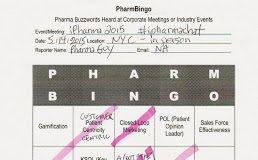“Twitter just announced a complex, confusing, and developer-alienating system that restricts their once-open, always cherished but now apparently taken for granted API,” complained Michael Spitz, SVP and Managing Director at Zemoga. “The new rules change the playing field for third party developers, establish caps on number of users, and shift guidelines to requirements across four categories of businesses that Danny Sullivan of Search Engine Land humorously characterized in Star Trek terms.” Spitz characterized this as #TWITTERFAIL and he thinks the new rules “ruin the spirit of social media” and are “bad for healthcare” (see here).
Spitz’s “rant” raises a couple of interesting issues that I will discuss with him this afternoon in a live Pharma Marketing Talk podcast (listen here or use the playback widget below).
First, the premise that changes to Twitter’s API can be “bad” for healthcare is based upon the notion that Twitter has been or could be “good” for healthcare. I’m not sure what Spitz includes in his “healthcare” category. Since he works for an agency with pharmaceutical company clients, I am sure he includes the drug industry as part of what he means by healthcare. I’d like to focus at least part of today’s discussion on how Twitter can be good (or bad) for the pharma industry’s goals of selling more drugs.
I have written several articles about how pharma can use Twitter to help support patients (see “Supporting Patients via Twitter and Beyond” and “Use of Twitter for Patient Support“) and criticized pharma for using Twitter (and blogs) to promote their products (ie, “market”; see “Novo Nordisk’s Branded (Levemir) Tweet is Sleazy Twitter Spam!” and “AstraZeneca’s Timely CRESTOR Branded Blog Post: Did It Violate Its Own Policy?“). My view is that Twitter has been good for pharma mainly in the public relations realm, which may or may not translate into increased drug sales.
Most tweets from pharmaceutical companies are about what they are doing in this therapeutic area or that therapeutic area (e.g., support for COPD, atrial fibrillation, diabetes innovation, etc.). Pharma tweets a lot about clinical study results (mostly the positive results) and news from medical conferences where they are exhibiting (“come to our booth”). They also tweet about investor presentations and other news about their company that Wall Street finds of interest.
None of those tweets do healthcare any good — e.g., improve outcomes of drug treatment. They do, however, provide benefit to pharma companies by getting them more attention by the media, which dutifully followup with articles based on these pharma “Tweet Releases.”
Another issue related to the lament about the more and more restrictive Twitter API is the question “Who Owns your Social media?”, which was brought to my attention by Phil Baumann of “Health is Social.” Baumann is also a member of the Advisory Board at Mayo Clinic Center for Social Media, so he has a healthcare perspective beyond pharma.
I invited Baumann to be a guest on this afternoon’s podcast, but he was not available. He did, however, send me some thoughts, one of which is:
“Too much emphasis has been placed on social media in general – at the expense of focusing on the only thing Healthcare or Pharma can own on the web: their own domains. Social Media should not be seen as the center of a web presence – ever. It’s a tempting thought, but the reality is the other way around. Healthcare and Pharma organizations should learn [from] these API changes that they don’t own anything on these social media sites. Many experts have laughed off blogging and traditional websites, but I still maintain that if you can’t build your own solid presence on your own domain, you won’t do well on social media in the long-run.”
You should also read “The Over-promising of Healthcare Social Media” written by Baumann.
Here are a few other thoughts from Baumann on the Twitter API issue:
- The first thing that Healthcare and Pharma need to realize is that social software is pliant and tenuous. With social software, the tiniest tweaks can produce huge ramifications throughout a digital ecosystem.
- If the industries are going to be involved in social media, they need people on staff who can keep up with the technical changes that happen – in fact, they need to anticipate them and have plans to turn to when those changes take place.
- The average person probably only cares about Twitter clients – I suspect that Twitter will eventually whittle clients down to a very few. It already owns TweetDeck, but hasn’t developed this asset much.
- The larger Healthcare/Pharma Enterprise impacts of the API changes are likely to be more in the area of data-mining, monitoring, metrics, etc. For example, Twitter might rate-limit calls for certain kinds of data – let’s say a Pharma company or its vendor monitors for mentions of a drug and or keywords related to possible Adverse Events. Depending on the API changes over time, there may be limits to the amount of data that can be captured in a timely manner.
- None of what Twitter is doing with its API is at all unexpected – at least it shouldn’t be. Ultimately, this is Twitter’s product – albeit one that increasingly is becoming a virtual public utility.









![6 Digital Tools at the Center of Healthcare Digitalization [INFOGRAPHIC]](http://ec2-54-175-84-28.compute-1.amazonaws.com/pharma-mkting.com/wp-content/uploads/2021/04/6DigitalTools_600px-100x70.jpg)




